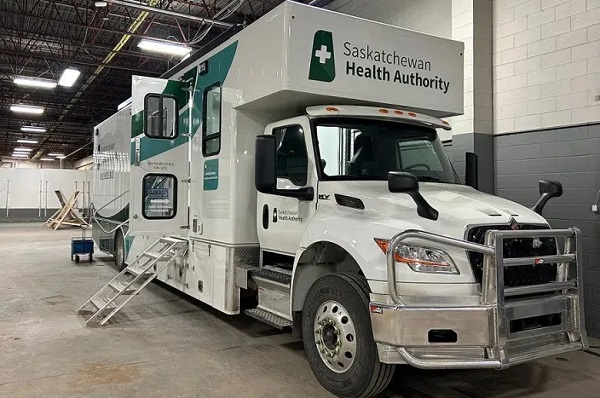Addictions
Alberta closing Red Deer’s only overdose prevention site in favor of recovery model

Alberta’s Minister of Mental Health and Addiction, Dan Williams, at the Alberta Legislature in Edmonton on Sept. 11 2024. [Photo credit: Alexandra Keeler]
Alberta’s Minister of Mental Health and Addiction explains the shift from overdose prevention to recovery amid community concerns
On Sept. 23, Alberta announced the city of Red Deer would be closing the community’s only overdose prevention site by spring 2025. The closure will mark the first time an Alberta community completely eliminates its supervised consumption services.
The decision to close the site was taken by the city — not the province. But it aligns with Alberta’s decision to prioritize recovery-focused approaches to addiction and mental health over harm-reduction strategies.
“The whole idea of the Alberta Recovery Model is that unless you create off-ramps [from] addiction, you’re barreling ahead towards a brick wall, and that’s going to be devastating,” Alberta Minister of Mental Health and Addiction Dan Williams told Canadian Affairs in an interview in September.
However, the closure — which parallels similar moves by other provinces — has sparked debate over whether recovery-oriented models adequately meet the needs of at-risk populations.
The Alberta Recovery Model
The Alberta Recovery Model, which was first introduced by Alberta’s UCP government in November 2023, emphasizes prevention, early intervention, treatment and recovery.
It is informed by recommendations from Alberta’s Mental Health and Addiction Advisory Council and research from the Stanford Lancet Commission on the North American Opioid Crisis.
“Alberta, in our continuum of care, has everything from low entry, low barriers, and zero cost [for] detox, to treatment, to virtual opioid dependency, to outreach teams working with shelters,” said Williams.
Williams said that Alberta intends to continue funding safe consumption sites as short-term harm-reduction measures. But it views them as temporary components in the continuum of care.
This is not without controversy.
At the Feb. 15 Red Deer council meeting where councillors voted 5-2 to close the city’s safe consumption site, some councillors noted that safe consumption sites play an essential role in the continuum of care.
“Each individual is at a different stage of addiction … the overdose prevention site does play a role in the treatment spectrum,” said Coun. Dianne Wyntjes, who voted against the closure.
While Red Deer is home to Alberta’s first provincially funded addiction treatment facility, Wyntjes noted there had been reports within the community of the facility lacking capacity to meet demand.
She pointed to Lethbridge’s experience in 2020, where overdose deaths spiked after its consumption site was replaced with mobile services.
The Ontario government’s recent decision to close 10 safe consumption sites located near schools and daycares has prompted similar concerns.
In August, Ontario Health Minister Sylvia Jones told reporters that the province plans to “very quickly” replace the closed sites with Homelessness and Addiction Recovery Treatment (HART) hubs that prioritize community safety, treatment and recovery. But critics — including site workers, NDP MPPs and harm-reduction advocates — have warned these shutdowns will lead to an increase in fatal overdoses.
It is possible that Alberta, Ontario and other jurisdictions will make other moves in tandem in the coming months and years.
In April, Alberta announced it was partnering with Ontario and Saskatchewan to build recovery-focused care systems. The partnerships include sharing of best practices and advocating for recovery-focused policies and investments at the federal level.
Our content is always free – but if you want to help us commission more high-quality journalism, consider getting a voluntary paid subscription.
‘Mandatory treatment’
Another controversial component of Alberta — and other provinces’ — recovery-oriented strategy is involuntary care.
The UCP government has said it plans to introduce “compassionate intervention” legislation next year that will enable family members, doctors or police officers to seek court orders mandating treatment for individuals with substance use disorders who pose a risk to themselves or others.
“If someone is a danger to themselves or others in the most extreme circumstances because of their addiction, then we as a society have an obligation to intervene, and that might include mandatory treatment,” said Williams.
Critics have raised concerns about increasing reliance on involuntary care options.
“Over the last two decades, there has been a dramatic increase in reliance on involuntary services [such as psychiatric admissions and treatment orders], while voluntary services have not kept up with demand,” the B.C. division of the Canadian Mental Health Association said in a Sept. 18 statement published on their website.
The statement followed an announcement by B.C. Premier David Eby — who was recently reelected — to expand involuntary care in that province.
Research from Yale University’s School of Public Health indicates involuntary interventions for substance use are generally no more effective than voluntary treatment, and can in some cases cause more harm than good. The research notes that “involuntary centers often serve as venues for abuse.”
A 2023 McMaster University study that synthesized the research on involuntary treatment from international jurisdictions similarly found inconclusive outcomes. It recommended expanding voluntary care options to minimize reliance on involuntary measures.
Williams emphasized that the province’s involuntary care legislation would target “a very small group of people for whom all else has failed … those at the far end of the addiction spectrum with very serious and devastating addictions.”
‘Off-ramps from addiction’
Over the past six years, Alberta has incrementally increased its mental health and addiction budget from an initial $50 million to a cumulative total of $1.5 billion.
The funding boost has enabled Alberta to eliminate a $40 daily user fee for some detox and recovery services, add 10,000 publicly funded addiction treatment spaces, and expand access to its Virtual Opioid Dependency Program, which offers same-day access to life-saving medications.
To support addiction prevention, Williams said Alberta is expanding CASA Classrooms in schools. These offer mental health support and therapy to Grade 4-12 students who have ongoing mental health challenges, and equip school staff and caregivers to support these students.
“Mental health and addiction needs to be as connected to the emergency room as it is to the classroom,” Williams said. “We need to be able to understand low-acuity chronic mental health challenges as they begin to manifest [in the community].”
The province is also in the process of establishing 11 residential recovery communities across the province. These centres provide free, extended treatment averaging four months — which is longer than most recovery programs.
Oct. 23 marked the one-year anniversary of one such centre, the Lethbridge Recovery Community. The $19-million, 50-bed facility served more than 110 clients in its first year and expects to serve about 200 individuals in 2025.
“I’m coming to see that entering treatment is only the start,” said Sean P., a client of Lethbridge Recovery Community, in a government press release celebrating the anniversary.
“With the support of the staff and the community here, I’m beginning to face my past and make real changes. Recovery is giving me the tools I need for this journey, and I’m genuinely excited to keep growing and moving forward with their help.”
Our content is always free – but if you want to help us commission more high-quality journalism, consider getting a voluntary paid subscription.
Addictions
New RCMP program steering opioid addicted towards treatment and recovery

News release from Alberta RCMP
Virtual Opioid Dependency Program serves vulnerable population in Red Deer
Since April 2024, your Alberta RCMP’s Community Safety and Well-being Branch (CSWB) has been piloting the Virtual Opioid Dependency Program (VODP) program in Red Deer to assist those facing opioid dependency with initial-stage intervention services. VODP is a collaboration with the Government of Alberta, Recovery Alberta, and the Alberta RCMP, and was created to help address opioid addiction across the province.
Red Deer’s VODP consists of two teams, each consisting of a police officer and a paramedic. These teams cover the communities of Red Deer, Innisfail, Blackfalds and Sylvan Lake. The goal of the program is to have frontline points of contact that can assist opioid users by getting them access to treatment, counselling, and life-saving medication.
The Alberta RCMP’s role in VODP:
- Conducting outreach in the community, on foot, by vehicle, and even UTV, and interacting with vulnerable persons and talking with them about treatment options and making VODP referrals.
- Attending calls for service in which opioid use may be a factor, such as drug poisonings, open drug use in public, social diversion calls, etc.
- Administering medication such as Suboxone and Sublocade to opioid users who are arrested and lodged in RCMP cells and voluntarily wish to participate in VODP; these medications help with withdrawal symptoms and are the primary method for treating opioid addiction. Individuals may be provided ongoing treatment while in police custody or incarceration.
- Collaborating with agencies in the treatment and addiction space to work together on client care. Red Deer’s VODP chairs a quarterly Vulnerable Populations Working Group meeting consisting of a number of local stakeholders who come together to address both client and community needs.
While accountability for criminal actions is necessary, the Alberta RCMP recognizes that opioid addiction is part of larger social and health issues that require long-term supports. Often people facing addictions are among offenders who land in a cycle of criminality. As first responders, our officers are frequently in contact with these individuals. We are ideally placed to help connect those individuals with the VODP. The Alberta RCMP helps those individuals who wish to participate in the VODP by ensuring that they have access to necessary resources and receive the medical care they need, even while they are in police custody.
Since its start, the Red Deer program has made nearly 2,500 referrals and touchpoints with individuals, discussing VODP participation and treatment options. Some successes of the program include:
- In October 2024, Red Deer VODP assessed a 35-year-old male who was arrested and in police custody. The individual was put in contact with medical care and was prescribed and administered Suboxone. The team members did not have any contact with the male again until April 2025 when the individual visited the detachment to thank the team for treating him with care and dignity while in cells, and for getting him access to treatment. The individual stated he had been sober since, saying the treatment saved his life.
- In May 2025, the VODP team worked with a 14-year-old female who was arrested on warrants and lodged in RCMP cells. She had run away from home and was located downtown using opioids. The team spoke to the girl about treatment, was referred to VODP, and was administered Sublocade to treat her addiction. During follow-up, the team received positive feedback from both the family and the attending care providers.
The VODP provides same-day medication starts, opioid treatment transition services, and ongoing opioid dependency care to people anywhere in Alberta who are living with opioid addiction. Visit vodp.ca to learn more.
“This collaboration between Alberta’s Government, Recovery Alberta and the RCMP is a powerful example of how partnerships between health and public safety can change lives. The Virtual Opioid Dependency Program can be the first step in a person’s journey to recovery,” says Alberta’s Minister of Mental Health and Addiction Rick Wilson. “By connecting people to treatment when and where they need it most, we are helping build more paths to recovery and to a healthier Alberta.”
“Part of the Alberta RCMP’s CSWB mandate is the enhancement of public safety through community partnerships,” says Supt. Holly Glassford, Detachment Commander of Red Deer RCMP. “Through VODP, we are committed to building upon community partnerships with social and health agencies, so that we can increase accessibility to supports in our city and reduce crime in Red Deer. Together we are creating a stronger, safer Alberta.”
Addictions
Saskatchewan launches small fleet of wellness buses to expand addictions care

By Alexandra Keeler
Across Canada, mobile health models are increasingly being used to offer care to rural and underserved communities
Saskatchewan has launched a small fleet of mobile wellness buses to improve access to primary health care, mental health and addiction services in the province.
The first bus began operating in Regina on Feb. 12. Another followed in Prince Albert on March 21. Saskatoon’s bus was unveiled publicly on April 9. All three are former coach buses that have been retrofitted to provide health care to communities facing barriers to access.
“Mobile health units are proven to improve outcomes for people facing barriers to healthcare,” Kayla DeMong, the executive director of addiction treatment centre Prairie Harm Reduction, told Canadian Affairs in an email.
“We fully support this innovative approach and are excited to work alongside the health bus teams to ensure the people we support receive the care they need, when and where they need it.”
Wellness buses
Like all provinces, Saskatchewan has been grappling with the opioid crisis.
In 2023, an estimated 457 individuals died from overdoses in the province. In 2024, that number fell to 346. But the province continues to struggle with fatal and non-fatal overdoses.
In late February, Saskatoon firefighters responded to more than 25 overdoses in a single 24-hour period. Just over a week later, they responded to 37 overdoses within another 24-hour window.
Saskatchewan’s wellness buses are part of the province’s plan to address these problems. In April 2025, the province announced $2.4 million to purchase and retrofit three coach buses, plus $1.5 million in annual operating funds.
The buses operate on fixed schedules at designated locations around each city. Each bus is staffed with a nurse practitioner, nurse and assessor coordinator who offer services such as overdose reversal kits, addiction medicine and mental health referrals.
“By bringing services directly to where people are, the health buses foster safer, more welcoming spaces and help build trusting relationships between community members and care providers,” said DeMong, executive director of Prairie Harm Reduction.
Saskatoon-based Prairie Harm Reduction is one of the local organizations that partners with the buses to provide additional support services. Prairie Harm Reduction provides a range of family, youth and community supports, and also houses the province’s only fixed supervised consumption site.
The mobile model
Saskatchewan is not the only province using wellness buses. Across Canada, mobile health models are increasingly being used to expand access to care in rural and underserved communities.
In Kingston, Ont., the Street Health Centre operates a retrofitted RV called PORCH (Portable Outreach Care Hub) that serves individuals struggling with homelessness and addiction.
“Our outreach services are extremely popular with our clients and community partners,” Donna Glasspoole, manager at Street Health Centre, said in an emailed statement.
“PORCH hits the road two to three days/week and offers a variety of services, which are dependent on the health care providers and community partners aboard.”
Street Health Centre also has a shuttle service that picks up clients in shelters and brings them to medical clinics or addiction medicine clinics.
The PORCH vehicles are not supported by provincial funding, but instead rely on support from the United Way and other grants. Glasspoole says the centre’s permanent location — which does receive government funding — is more cost-effective to operate.
“The vehicles are expensive to operate and our RV is not great in winter months and requires indoor parking,” she said.

Politically palatable
Many mobile health models currently do not provide controversial services such as supervised drug consumption.
The Saskatchewan Health Authority told Canadian Affairs the province’s new wellness buses will not offer supervised consumption services or safer supply, where drug users are given prescribed opioids as an alternative to toxic street drugs.
“There are no plans to provide supervised consumption services from the wellness buses,” Saskatchewan Health Authority spokesperson Courtney Markewich told Canadian Affairs in a phone call.
This limited scope may make mobile services more politically palatable in provinces that have resisted harm reduction measures.
In Ontario, some harm reduction programs have shifted to mobile models following Premier Doug Ford’s decision to suspend supervised consumption services located within 200 metres of schools and daycares.
In April, Toronto Public Health ended operations at its Victoria Street fixed consumption site, replacing it with street outreach and mobile vans.
The Ontario government’s decision to close the sites is part of a broader pivot away from harm reduction. The province is investing $378 million to transition suspended sites into 19 new “HART Hubs” that offer primary care, mental health, addictions treatment and other supports.
Glasspoole says that what matters most is not whether services are provided at fixed or mobile locations, but how care is delivered.
Models that “reduce barriers to care, [are] non-judgemental, and [are staffed by] trauma-informed providers” are what lead more people toward treatment and recovery, she said in her email.
In Saskatchewan, DeMong hopes the province’s new wellness buses help address persistent service gaps and build trust with underserved communities.
“This initiative is a vital step toward filling long-standing gaps in the continuum of care by providing low-barrier, community-based access to health-care services,” she said.
This article was produced through the Breaking Needles Fellowship Program, which provided a grant to Canadian Affairs, a digital media outlet, to fund journalism exploring addiction and crime in Canada. Articles produced through the Fellowship are co-published by Break The Needle and Canadian Affairs.
Subscribe to Break The Needle
-

 conflict2 days ago
conflict2 days agoOne dead, over 60 injured after Iranian missiles pierce Iron Dome
-

 Crime14 hours ago
Crime14 hours agoManhunt on for suspect in shooting deaths of Minnesota House speaker, husband
-

 Business3 hours ago
Business3 hours agoCarney’s European pivot could quietly reshape Canada’s sovereignty
-

 Alberta3 hours ago
Alberta3 hours agoAlberta’s grand bargain with Canada includes a new pipeline to Prince Rupert




